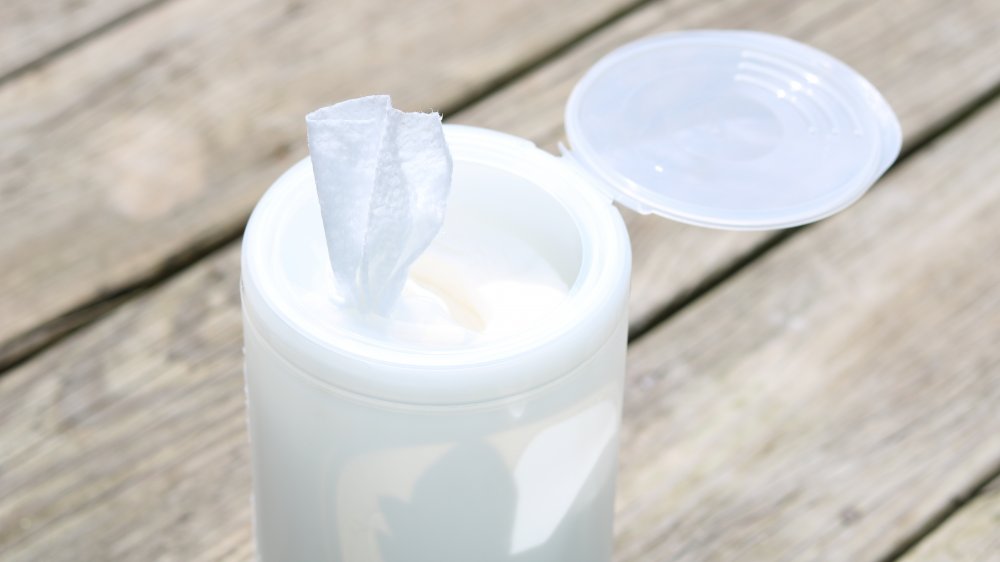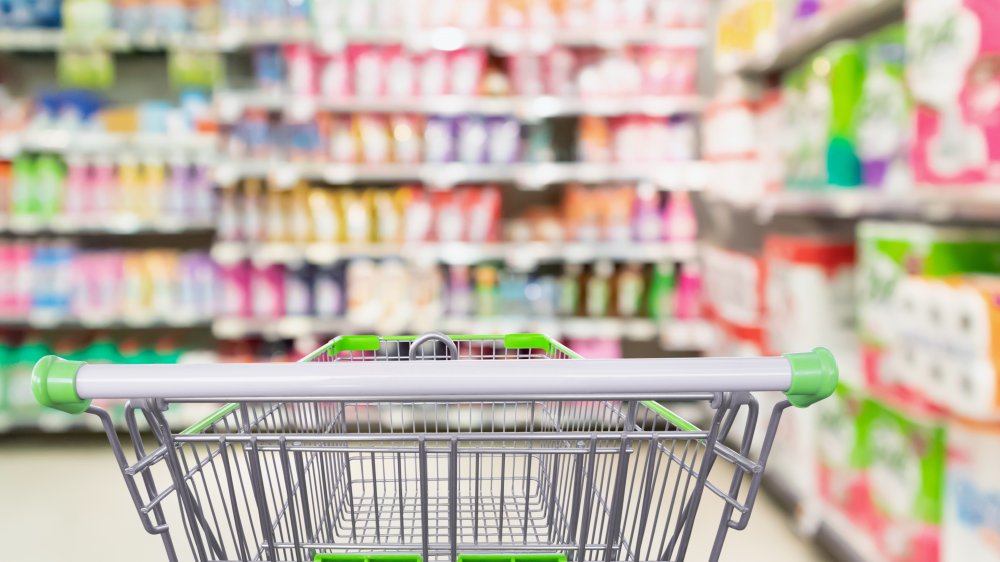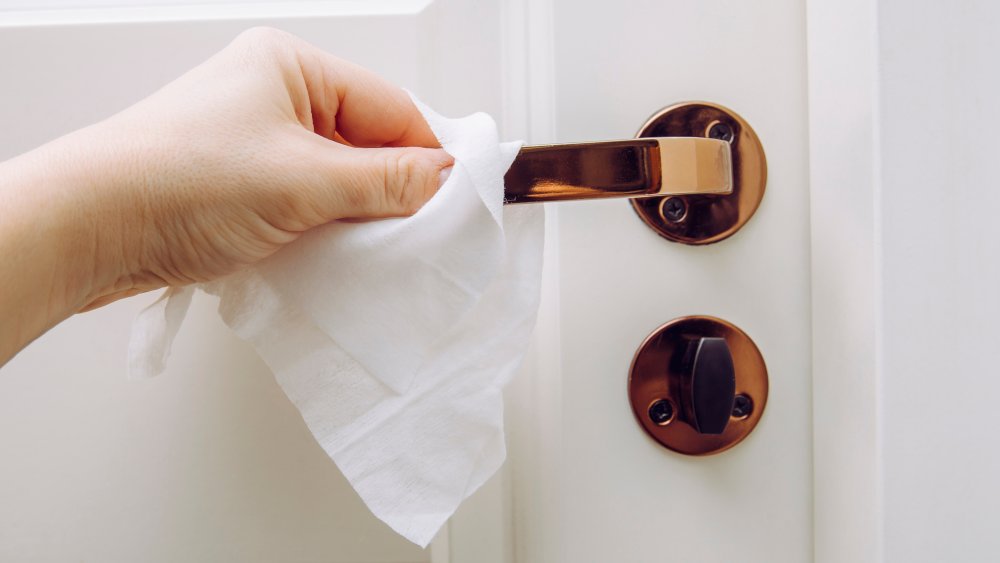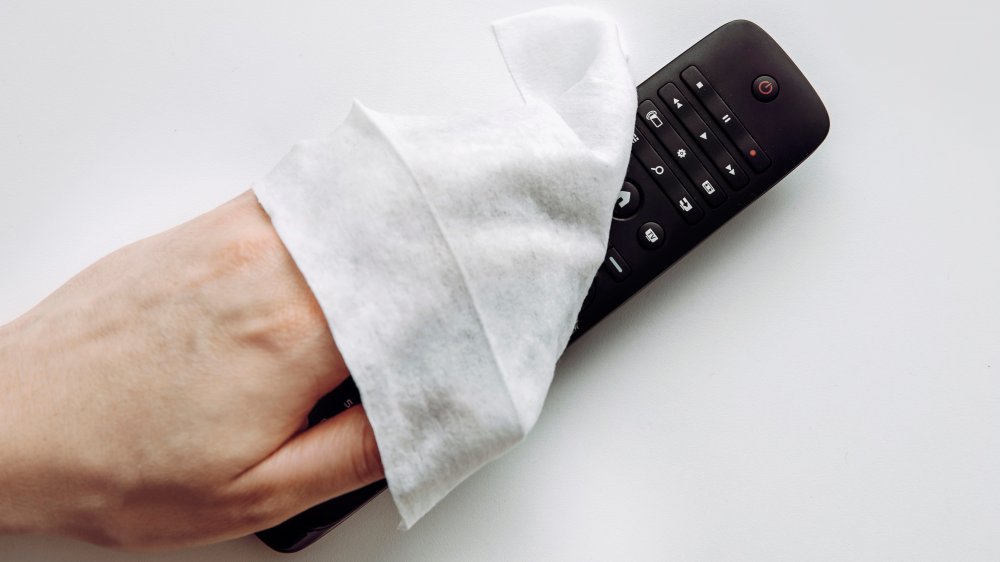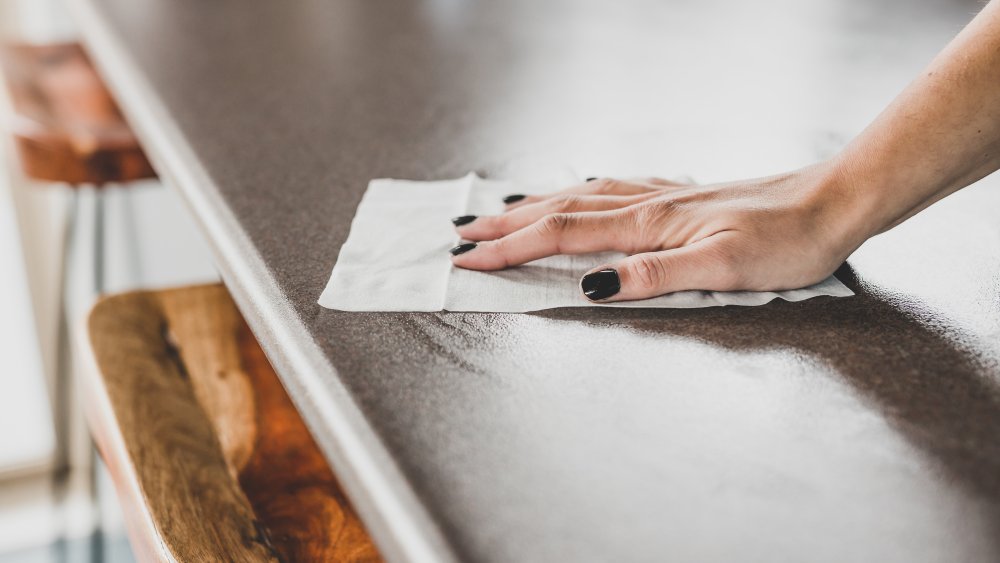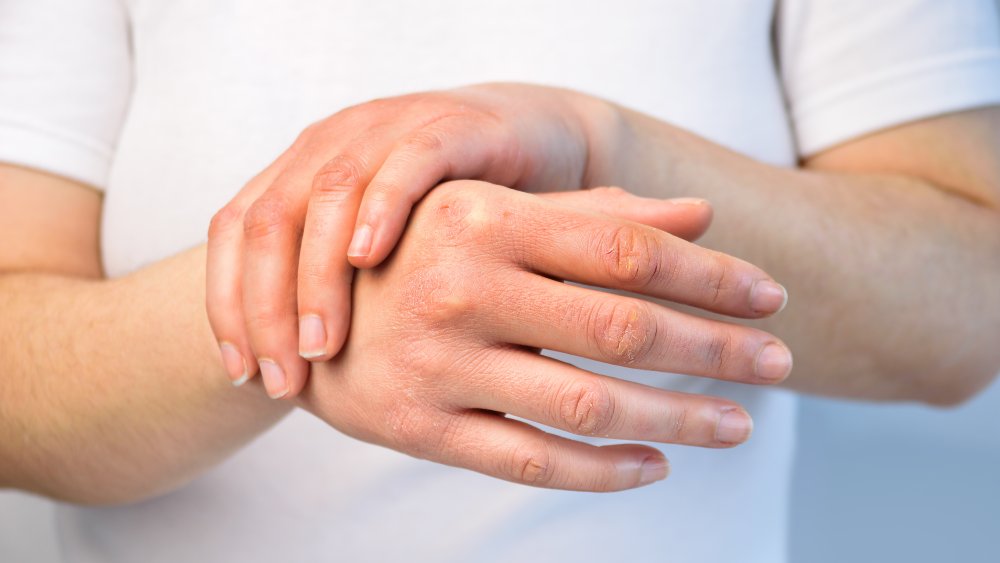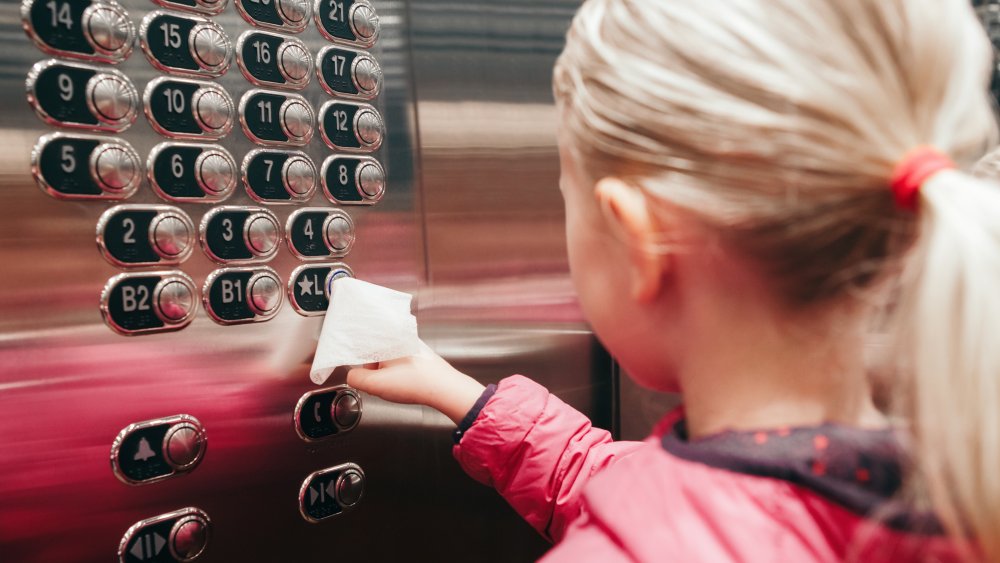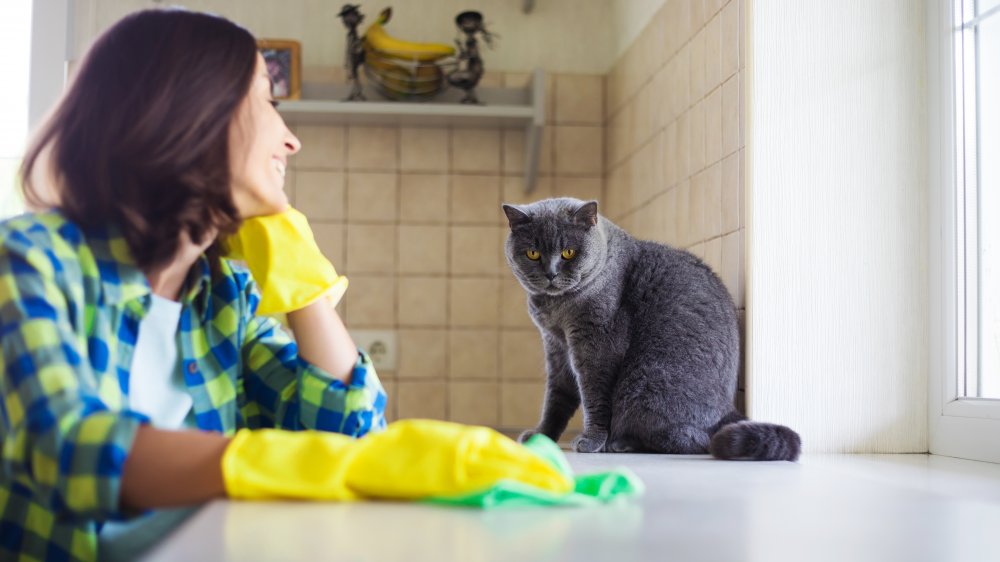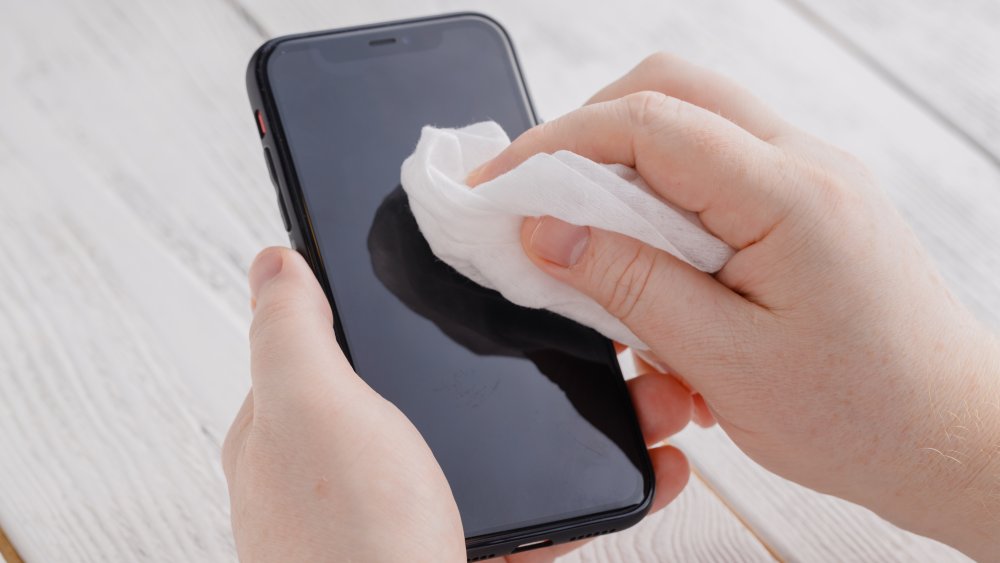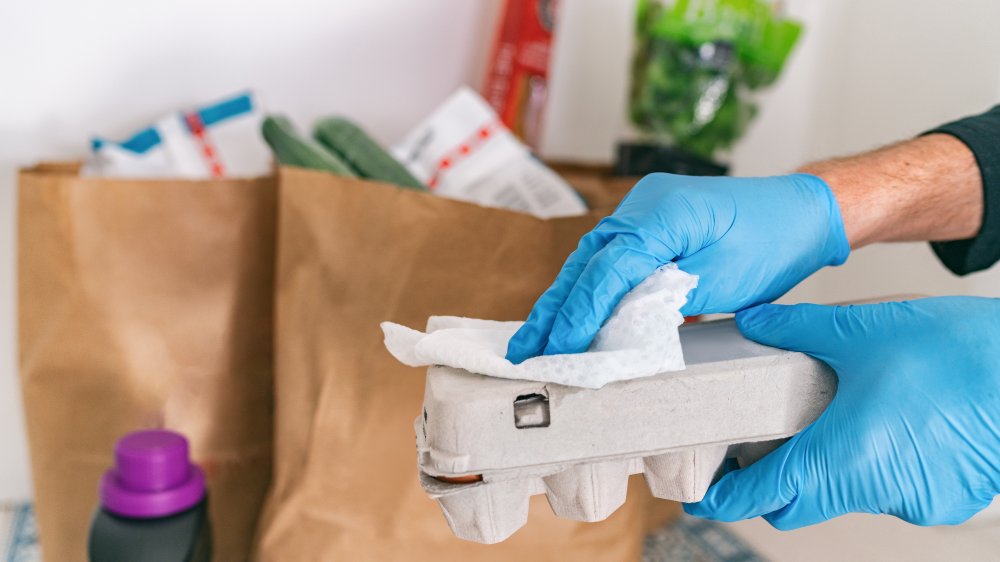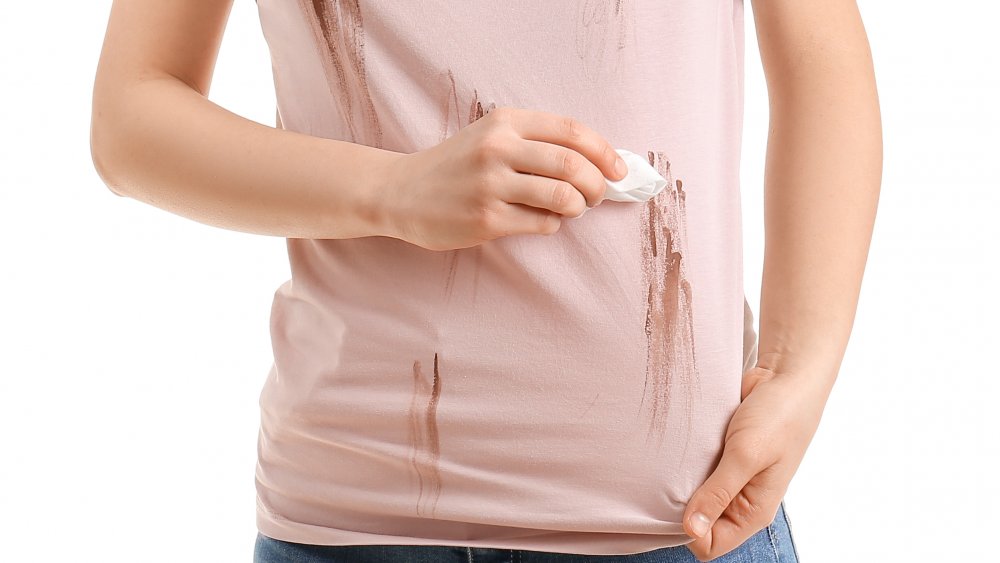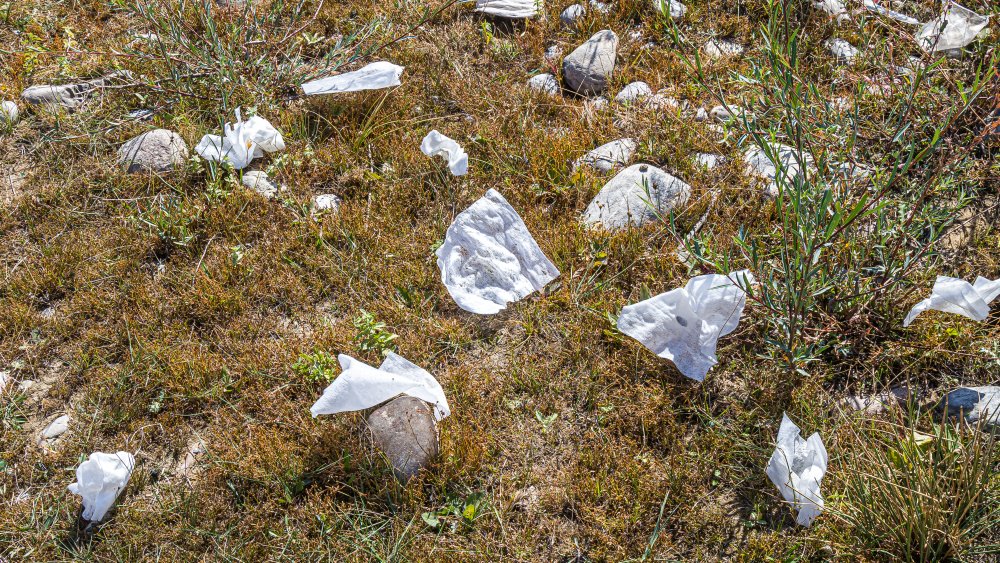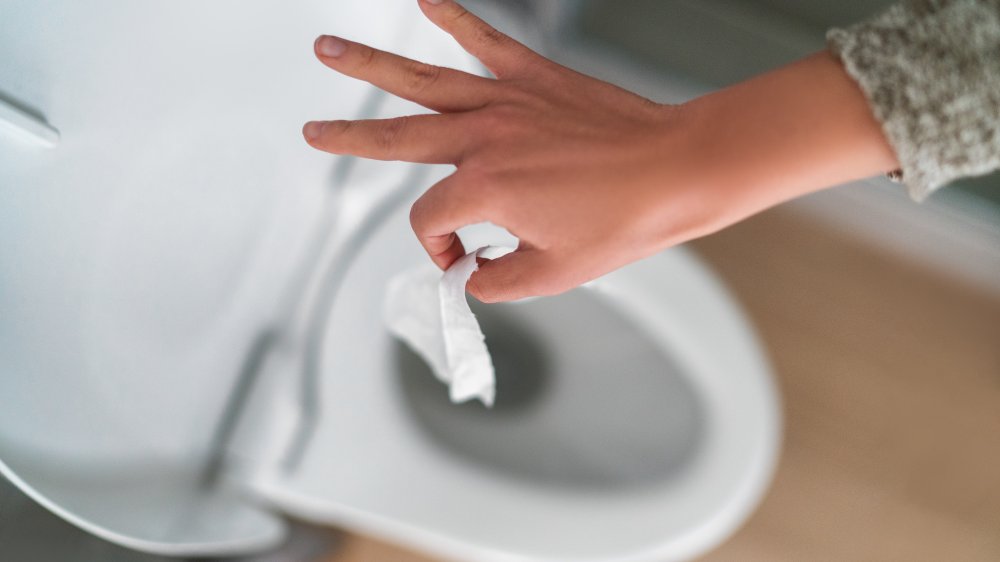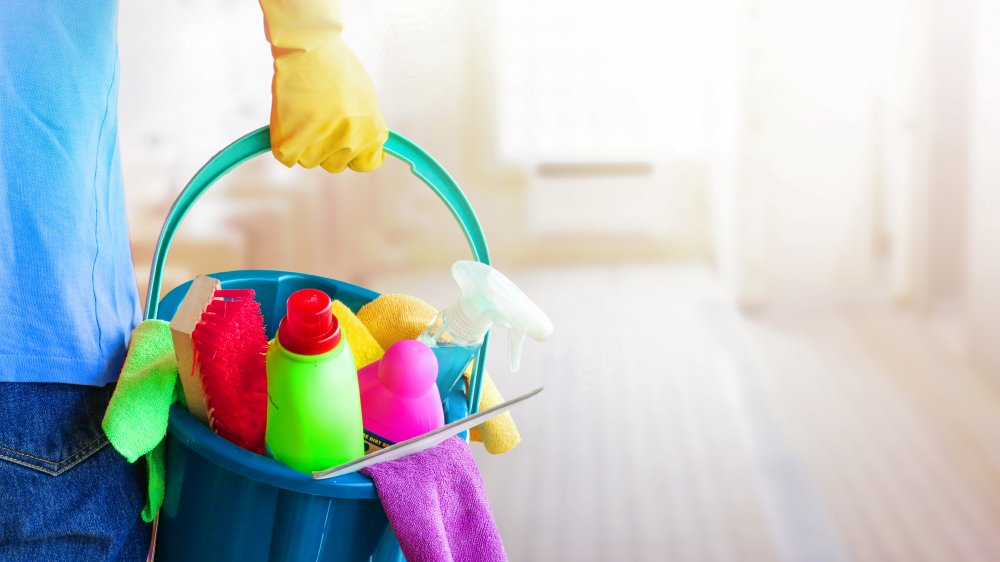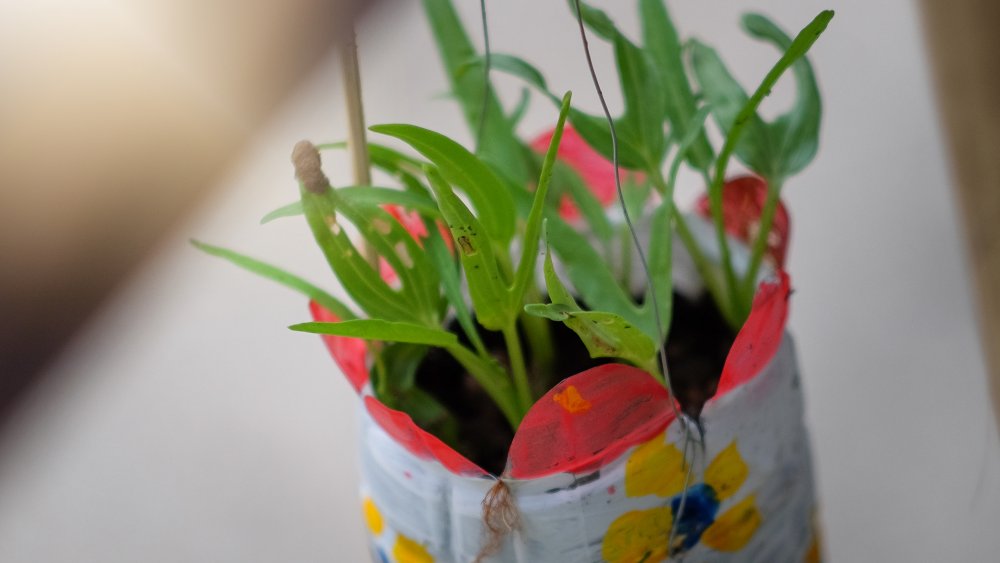Here's What You Really Need To Know About Disinfecting Wipes
Disinfecting wipes probably weren't on your mind in 2019, but by late winter 2020 these wipes became one of the things we were all talking about — and scouring department stores and grocery stores hoping to find. Invented some two decades ago, disinfecting wipes have been a standard weapon in our war against germs for years (via Clorox). Of course, you may not have paid them much mind until COVID-19 came about.
Sales of cleaning products of all types exploded as America was learning how to best protect against coronavirus. Clorox, the leader in the industry, initially struggled to meet the increased demand. The New York Times reported that since spring 2020, their sales of disinfecting wipes had surged by nearly 500 percent. After ramping up production, the company began packaging one million canisters of disinfecting wipes daily. "It plans to further increase production early [2021]," the publication revealed.
So, as you continue to hunt for the prized product or make the best of what you have left, here are a few keys things you need to know about the ever-elusive disinfecting wipes.
Understand what kind of wipes you're buying
Just because all the various wipes at your local department store or supermarket look the same and all come in similar-looking plastic tubes, that doesn't mean they all work the exact same way.
Montgomery Dermatology in King of Prussia, Pennsylvania broke down the difference between various wipes on its site: "Sanitizing refers to reducing — not killing — bacteria, fungi and viruses on surfaces and skin." Baby wipes, for instance, are generally considered sanitizing, not disinfecting. "Disinfecting refers to killing the microscopic organisms," the dermatology practice continued. If you want to kill viruses like COVID-19 or the flu, you need disinfecting wipes as opposed to sanitizing wipes. The active ingredient in most disinfecting wipes is alcohol, but other ingredients are also included, like chlorine, glutaraldehyde, formaldehyde, hydrogen peroxide, or iodine — all of which can kill germs by either dissolving their cell walls, puncturing through those walls, or breaking the bonds that hold the exterior wall of the germ together.
Still confused? Just remember that most wet wipes, baby wipes, and cleaning wipes that you see in stores are going to be recommended for sanitizing. Only disinfecting wipes that promote themselves as such will actually kill germs.
High-touch areas in the home are the most important spots to disinfect
It's Sunday and you're about to tackle your household chores before the workweek rolls around. But should you be cleaning everything in your place or do you need to disinfect? The good news, according to Penn Medicine, is that in most areas of the home, cleaning is enough. "Cleaning a surface — simply removing dirt and particles — is not the same thing as disinfecting it to kill viruses and bacteria," the site run by the University of Pennsylvania explained.
Go ahead and use your favorite soapy cleaning product with water and remove the buildup of dirt and dust that occurs naturally in all of our homes, but then plan on going back to the high-touch areas — areas more than one person frequently touches — where germs linger to disinfect. That means knobs, all exposed parts of the refrigerator, bathroom surfaces (especially on or around the toilet), eating areas, light switches, faucets, stair railings, shared electronics like computer keyboards, and places remote controls and other shared objects are stored.
Disinfecting wipes are really good at what they do
Despite their ubiquity and contagiousness, the germs that cause many serious illnesses can be killed fairly easily. The United States Environmental Protection Agency has compiled a comprehensive list of products for safe and effective use against COVID-19. What about the germs that cause the common cold and the flu? NBC's Today reported that while these villains can live on surfaces for up to 24 hours, you can successfully keep them at bay with proper use of a number of different products, including disinfecting wipes.
Such wipes are even gaining acceptance as a tool against germs in hospitals, where older, more traditional methods have typically been preferred. Research published in the journal Antimicrobial Resistance & Infection Control found that when used according to manufacturer recommendations, disinfecting wipes are "one of the most efficient" methods for decontaminating "high-touch environmental surfaces and non-critical medical devices in hospitals and other healthcare centers."
When using disinfecting wipes in your home, remember that you don't need to wipe the entire house down. Focus on areas that are touched the most or that get the most traffic from the people around you. That's where these germs are most likely to be.
Always give your disinfecting wipes time to work
Cleaning and disinfecting is not the most enjoyable experience for a lot of people. As such, many want to get it done and over with as quickly as possible. However, disinfectants need time to work. Just quickly dabbing some product on a germy surface isn't enough to disinfect it. You need to rub the surface until visibly wet to maximize contact time between the chemical and the germs you're trying to destroy and then let the surface air dry.
In a review of proper cleaning techniques, The New York Times warned that many people need considerably more product than they might expect. Check the label of disinfecting wipes you're using and make sure you wipe the surface down significantly enough that it stays wet for as long as the manufacturer recommends. As the publication pointed out, some products may suggest just 60 seconds, but others may recommend three to four minutes. You may have to use several wipes to make it happen.
Since products contain different chemicals in different formulations, you have to follow what the label says, advised Andrew Janowski, an infectious disease expert. "The longer you can let [the disinfectant and the surface] be in contact, the better," he said.
Disinfecting wipes may irritate your skin
Although the chemicals found in disinfecting wipes are technically classified as pesticides, as that's the name the EPA uses to describe any chemical that seeks out and destroys a "pest" (in this case bacteria and viruses). Nevertheless, the National Capital Poison Center has reported that the products are generally safe when used properly. Concentrations of the chemicals within the wipes are not strong enough to break down and enter human cells, the center said. That's why they are safe to be held in the hand.
However, that's not to say irritation can't occur. "It's a very heterogenous group of wipes out there, and they're made of different things," Carrie L. Kovarik, dermatologist and member of the American Academy of Dermatology COVID-19 Task Force, told Livestrong. "Some of them have bleach in them, some of them have ammonium chloride — which is what a lot of the Clorox and Lysol products have — and most of them have some percentage of alcohol."
Beth Ann Lambert, system infection control supervisor for the Center for Quality and Patient Safety at Ochsner Health in Louisiana, told the publication, "The majority of surface disinfectants do say [to] wear gloves or wash hands after use."
Disinfecting wipes aren't safe for children
As the warning often goes: Keep out of reach of children. Parents should always make sure children are out of the room before using disinfecting wipes or other disinfectants, warned Consumer Reports. This will ensure small hands stay out of the cleaning liquid, preventing unwanted chemicals from ending up in the eyes or mouth. Also keep in mind — especially if your child has asthma — that fumes from some disinfectants can linger in the air for up to 20 minutes after use, according to a study published in the journal Environmental Health.
While the effects of such fumes aren't fully understood, research has shown that asthma develops more frequently in janitors and healthcare workers than in people working in other careers, potentially because they breathe in more of the products' fumes (via Consumer Reports). Another study cited by Consumer Reports found that some cleaning products may also be a trigger for respiratory irritation in school-age children.
If you're concerned, check your product's ingredient label for "alkyl dimethyl benzyl ammonium chloride" and other types of "benzyl ammonium chloride" as they appear to be the most likely triggers of the irritation.
You should keep disinfecting wipes away from pets
Using disinfecting wipes on or around cats, dogs, or other small household animals is a definite no-no. And exposure to the products can happen far more easily than you might think. Your cat may jump onto an area you've just wiped down or your dog may decide to "retrieve" any wipes accidentally left behind. Your pets could easily get disinfectant on their paws or other parts of their fur and then lick it off later.
The best advice for pet owners, according to the Humane Society, is to always keep pets shut in another room while cleaning and disinfecting to make sure they have no chance of coming into contact with whatever cleaning sprays or disinfecting wipes you might be using. Cats and small dogs are particularly vulnerable. Due to their size, their livers are unable to deal with toxins well, Danielle Bays, an animal safety expert with the Humane Society, explained. Think of your pets like you would your children, Hodges added. "Small amounts of things can really, really hurt them."
It's safe to use disinfecting wipes on your phone
Think how often you handle your phone on a daily basis — and all the many places you put it down. Then consider that the average cell phone is some 10 times dirtier than the average toilet, according to Time magazine. It makes sense when you think about it. You carry a cell phone to the bathroom (you can admit it) and the bedroom. You lug it around in your pocket and take it out when you eat or when you down on the couch. These activities all makes the surface of most phones the perfect breeding ground for all sorts of viruses and bacteria.
While many cell phone manufacturers, like Apple, had previously recommended against using disinfecting wipes on their products, many reconsidered at the outset of coronavirus. The general advice as of March 2020, according to CNBC: Alcohol wipes and disinfecting wipes are safe to use if used correctly. You'll want to turn your phone off before disinfecting and wipe the product thoroughly but gently — being extra cautious to avoid getting any moisture in the charging port or speaker grilles.
Should you use disinfecting wipes on your groceries?
We've all heard stories detailing the elaborate means some have gone through to in order to disinfect their groceries. However, most experts agree these efforts are not necessary. Donald Schaffner, a microbiologist and professor at Rutgers University, and other experts explained to NPR that there are a number of reasons why the groceries and packaged foods you buy at the market are much less likely to spread germs than simply being around other people while shopping.
First, consider that viruses tend to start losing their infectiousness as soon as they land on a surface. The probability of a germ making its way into your body from something you buy isn't nil, but it is very low, virologist Angela Rasmussen added. What's more, Schaffner warned that using disinfecting wipes on foods that come in more delicate packaging may contaminate the food if the disinfectant is able to soak through.
Disinfecting wipes are especially discouraged for use on fruits and vegetables, since you may end up consuming some of the chemicals within the wipes and risk getting sick, Felicia Goulet-Miller, an instructor of microbiology at Florida Gulf Coast University, told USA Today. Simply rinsing your produce and washing your hands after shopping and after unpacking groceries is really all that's required.
Don't use disinfecting wipes on clothing or wood
While hard surfaces are considered the most effective spots to use disinfecting wipes, there are some definite areas in which you should not use a wipe. According to BobVila.com, you should never use a disinfecting wipe on a few key places in your home. If you were to use one of these wipes on a granite countertops, the chemicals could eat away at the sealant covering the counter, increasing its risk for defects and discoloration.
The site also advised against using disinfecting wipes to sanitize your sofa or remove stains from clothing. In both cases, the alcohol within the wipes could discolor or stain the fabric. Avoid using disinfecting wipes on leather couches — and leather seats in your car — as they can eliminate natural oils in the leather and leave the material dry and brittle. Finally, avoid using disinfecting wipes on unfinished wood. "Since untreated or unpainted wood is porous," the site warned, "disinfectant wipes can leave it with a big, ugly stain."
Disinfecting wipes aren't recyclable or biodegradable
To keep disinfecting wipes from breaking down after they are produced and shoved in that tube, manufacturers fill them with synthetic fibers that help them to stay wet and useable after you purchase them from the store. The problem? These fibers render the wipes non-recyclable and "mostly not compostable," according to Green Matters. Considering we use them constantly to disinfect almost everything in our homes and the things we touch in public spaces, like shopping carts and door knobs, it makes sense that they "represent a large proportion of non-biodegradable waste in landfills," the site revealed.
A study found that the number of used wipes found along the coastline in the U.K. increased by more than 400 percent over the previous decade (via The Guardian). Your best bet to help reduce some of this damage to the planet? Only use wipes in high-touch or high-traffic areas that need the disinfecting — and don't use them to clean your entire home.
Disinfecting wipes shouldn't be flushed
Tossing a used disinfecting wipe in the toilet might seem like an easy way to get rid of it, but flushed wipes are bad for your home's plumbing and a major nuisance for cities across the nation.
According to CNN, many large urban areas, like in California, use centralized sewage collection systems. Waste moves through these systems through a combination of gravity and water flow. Toilet paper easily dissolves when wet, but disinfecting wipes don't. "Flushing wipes, paper towels and similar products down toilets will clog sewers and cause backups and overflows at wastewater treatment facilities," the California Water Resources Control Board warned in a news release.
Even "flushable" wipes can pose a problem since they're usually made of synthetic materials, CNN cautioned. "These materials, when combined with other personal hygiene products that are flushed and grease that is poured down drains, create what waste workers refer to as 'fatbergs' in sewers." Unfortunately, since disinfecting wipes are made of synthetic materials, they also can't be recycled, Green Matters explained. The only option is to throw them away with your trash.
You can make your own disinfecting wipes at home
Whether your local store has run out or you're looking to save a few bucks, homemade disinfecting wipes are a DIY breeze. According to Better Homes & Gardens, all you need to make them are paper towels or small kitchen cloths (if you want to make reusable wipes), an airtight storage container, and a disinfectant of your choice. Undiluted 70 percent rubbing alcohol is an affordable and highly effective disinfecting option. Just pour the alcohol into the container, add the cloths, and let soak for five minutes before use.
You can also make disinfecting wipes with bleach. Just remember that it can discolor surfaces it comes in contact with and can irritate your eyes, hands, and nose so always wear rubber gloves when handling. Also, never mix bleach with ammonia or other cleaning products as this can cause a serious and dangerous chemical reaction.
To make bleach-based disinfecting wipes, add 4 teaspoons of bleach plus a quart of water to your container, chuck in the cloths, and again let soak for five minutes before use. Both rubbing alcohol and bleach wipes will lose effectiveness after 24 hours, so only make them as you need them — like in a pinch when ready-made wipes aren't available.
You can't bring disinfecting wipes back to life with water
Depending on the brand, your disinfecting wipes will have a shelf life of about one year. Good news if you're going through yours quickly, but not so good if you bought in bulk. Whatever your supply of wipes, be sure to keep them stored in a cool, dry place. Reader's Digest warned that if you leave the wipe canister open or store it in an overly warm environment, the alcohol inside will quickly dry out, rendering the product "useless." And no, adding water back into the canister won't revive their disinfecting powers. However, you can revive the product by adding 70 percent rubbing alcohol to the container, Jim Roberts, director of environmental health at Champaign-Urbana Public Health District, told The News-Gazette. You should wait until the alcohol absorbs before using, though.
You can also get crafty and recycle the canister. Some people paint them or wrap them in colored paper, creating a home for plastic shopping bags. You can also remove the top and use the cup to hold pencils and pens or bathroom essentials like cotton balls. We even found some planters and candle holders made from the empty canisters. Let your imagination run wild!

